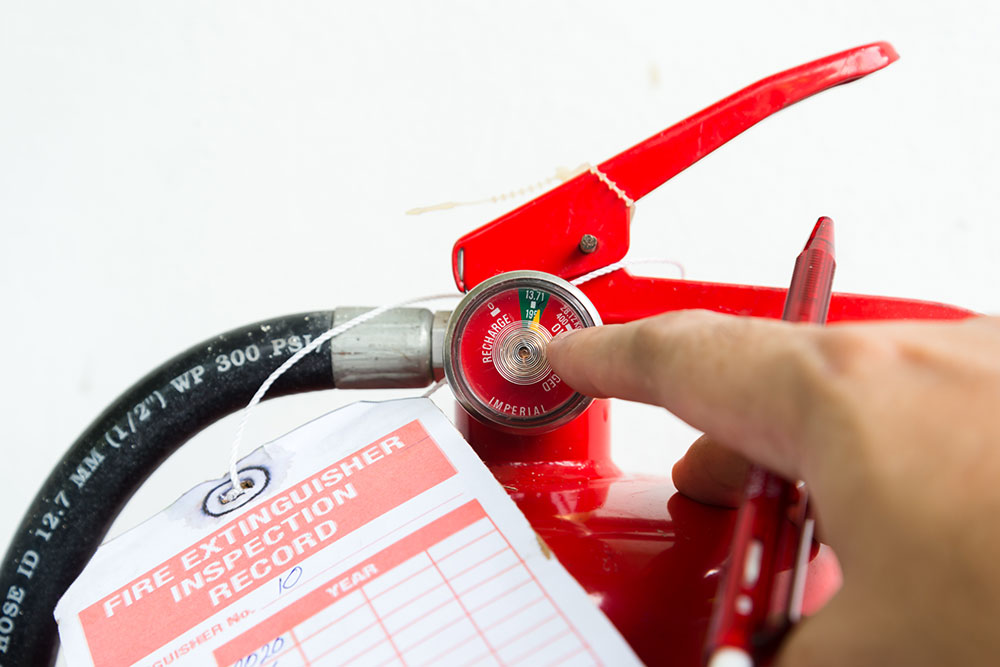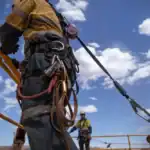
Fire extinguishers are unique. Incredibly important yet practically invisible. To most people, they’re just workplace wall dressing. But you can’t think the same if you’re responsible for fire safety. Every one of your extinguishers must be regularly serviced and ready for action. So, how often should you service fire extinguishers?
This guide explains how often fire extinguishers should be checked and who can check them. You can be sure your service schedule complies with fire safety regulations and trust your extinguishers are waiting in good working order if they’re ever needed.
What the Law Says
All non-domestic premises are subject to the Regulatory Reform (Fire Safety) Order 2005 (also known as the Fire Safety Order or FSO).
It’s the duty of the “responsible person” (the employer for workplaces or property manager for shared residential buildings) to comply with the FSO. As part of their duties, the responsible person must provide sufficient firefighting equipment for their premises and maintain it in good working order.
However, the FSO doesn’t specify what you need to do to achieve this aim. Article 17 of the FSO refers to the maintenance of fire extinguishers but doesn’t explain what this involves. Instead, it’s up to you as the responsible person to decide how often extinguishers should be checked to confirm they’re in good condition.
The safest and simplest way to ensure your fire extinguishers comply with the FSO is to follow BS 5306-3. This is the British Standard on firefighting equipment installation and maintenance.
Standard Servicing Schedule
British Standards aren’t law, so you don’t have to follow them. But they are developed specifically to help businesses comply with regulations, which are law. For most workplaces, following the fire extinguisher service schedule outlined in BS 5306-3 should ensure compliance with the FSO.
How often should you service fire extinguishers according to British Standards? The recommended schedule is:
- Monthly checks
- Annual inspections
- Extended service every 5 or 10 years, depending on the type of extinguisher
- Retirement after 20 years
Checks, inspections and services are separate procedures. Monthly checks are the lightest and mostly visual. Annual inspections are more in-depth and involve a physical examination of the extinguisher. And, as you might expect, extended services are the most thorough, requiring parts of the extinguisher to be dismantled, tested and reassembled.
You don’t need to carry out these examinations yourself. Nor should you. Each requires a level of knowledge, experience and training, which scales with the complexity of the task.
As a responsible person, you need to ensure that the people you appoint to check and service your extinguishers have the necessary knowledge, experience and training (i.e. are competent).
We’ve summarised each procedure below so you understand what each involves and who can perform them.
Fire Extinguisher Inspection Training
Our Fire Extinguisher Training course provides the know-how to work competently in case of a fire hazard. It provides vital information on the different types of fires, types of extinguishers and the right selection of the extinguisher in the event of a particular fire hazard.
Monthly Checks
Monthly checks are visual inspections. They’re more basic than other inspections, so they’re usually part of a fire warden’s duties. Anyone conducting a typical monthly check should confirm the following:
- No visible damage or wear and tear
- Current and readable service tags
- Correct pressure levels
The checker should also pick up the extinguisher to feel its weight. If a fire extinguisher is unusually light, it may be empty. A final check should verify the extinguisher is unobstructed and adequately signposted.
Monthly checks should be recorded. Fire extinguisher records are helpful in proving compliance with the FSO and indicating when it’s time for repair or replacement.

Annual Inspections
Annual inspections are more in-depth, so they require more expertise. Generally, inspections are done by professionals because they need more knowledge, experience and training to be competent.
Again, inspections and their outcomes should be recorded.
Extended Services
Extended services should happen every 5 years for powder, water and foam extinguishers. CO2 extinguishers should be serviced every 10 years.
As the most extensive examination, it’s best to leave these to a professional fire extinguisher engineer. And, as you might have guessed, these services should be documented.
Historically, extended services included a test discharge, but this isn’t always done. Fire extinguisher contents are hazardous waste and must be handled properly. Due to the difficulty of disposing of hazardous waste, the Environment Agency and BAFE (British Approvals for Fire Equipment) recommend replacing extinguishers instead of discharge testing.
Replacement
Regardless of inspection or service history, replacing all extinguishers after 20 years of service is recommended.
Can I Service Extinguishers Myself?
There’s no legal qualification to service fire extinguishers, so you can carry out some checks yourself. But, you must be competent.
It would be a significant investment of time and money to develop the competency needed to service extinguishers. And since services only need to happen once every 5 years (or 10 for CO2 extinguishers), most employers outsource.
However, many business owners find it cost-effective to train themselves (or an employee, such as their nominated fire warden) in fire extinguisher inspection. Inspections are more straightforward than services, so you can realistically develop the necessary competence without giving up your day job.
Moreover, visual inspections should happen at least once a month. That’s 12 checks for every extinguisher each calendar year (and you should have more than one extinguisher to comply with the FSO). Having someone competent on staff can quickly recoup training costs. It will also make compliance with the FSO more straightforward.
How Often Should You Service Fire Extinguishers – Key Takeaways
- According to British Standard BS 5306-3, you should carry out:
- Monthly checks
- Annual inspections
- Extended services every 5 years (or 10 years for CO2 extinguishers)
- All checks, inspections and services must be carried out by someone competent. Generally, only professional engineers are competent to conduct a full service. You can develop the competency to perform other checks through training.
Fire Extinguisher Inspection Training
Invest in our online Fire Extinguisher Training to develop the necessary competence to visually inspect extinguishers.
This multi-module course covers legal requirements, types of extinguishers and step-by-step inspection procedures. All content aligns with British Standard 5306–3 to ensure compliance with the Regulatory Reform (Fire Safety) Order 2005. You can move inspections in-house, improve fire safety and ensure compliance. Plus, you can guarantee that at least one of your employees is paying close attention to your fire extinguishers.






















